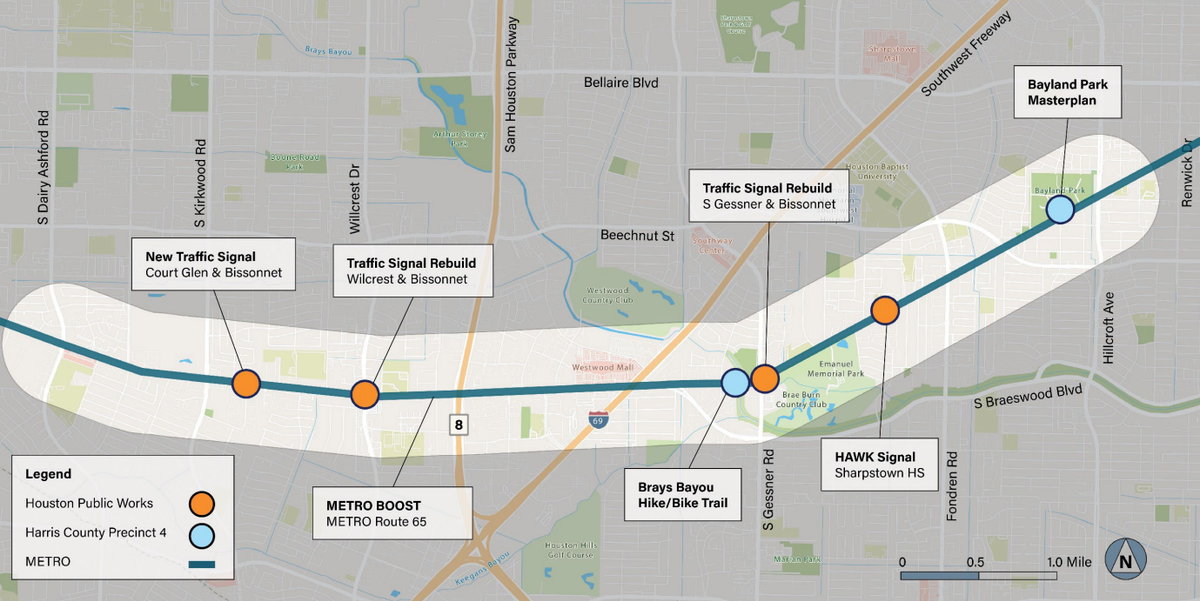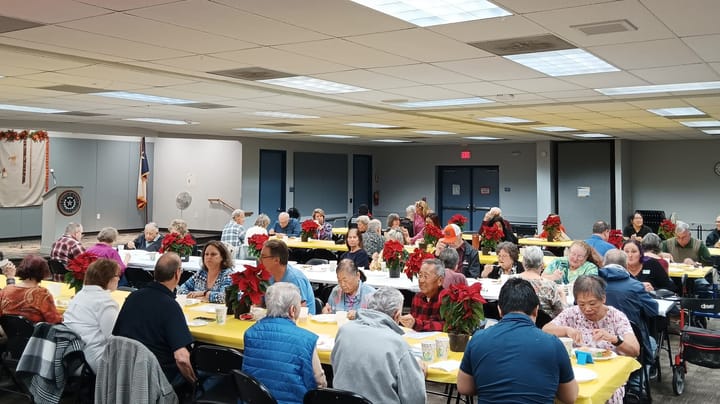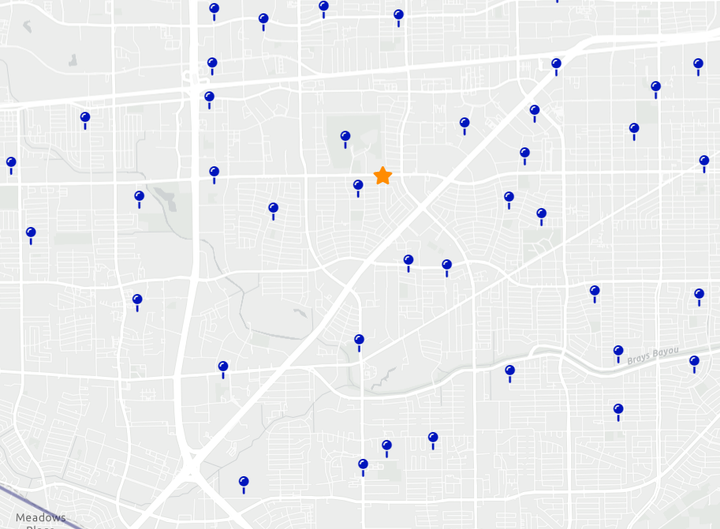How the Bissonnet Corridor Safe Streets Project Could Shape One of SW Houston's Most Dangerous Roads

This August, Houston Public Works will be putting the final touches on the initial design plans for the Bissonnet Corridor Safe Streets Project, which will reshape a seven-mile stretch of Bissonnet St. from Hillcroft to Dairy Ashford. That stretch of Bissonnet had 3012 crashes—68 of them KSI (killed-or-serious-injury) crashes—from 2018-2022, according to HPW data. That's why the project's main goal is to boost safety for drivers, cyclists, and pedestrians by redesigning intersections and crosswalks.
Planned improvements also include widening sidewalks to make them more ADA accessible, reducing median openings (potentially), creating more shade by planting trees, and addressing drainage issues by upgrading storm sewer inlets and fixing pavement to prevent ponding. At a July 17 community meeting at Bayland Park, project manager Donald Buaku said, “This is a rehabilitation, not a reconstruction,” so many of the changes are what some would consider “surface level.”
The project stirred up controversy in April because of residents' fears about road diet—a redesign strategy that attempts to reduce traffic speeds by narrowing some lanes and removing others entirely. Some of the original concept drawings from former mayor Sylvester Turner's federal grant application for Bissonnet included examples of road diet, which is unpopular with many Houston drivers.
But in 2024, new mayor John Whitmire has often frowned upon road diet in city projects. At an April community meeting at Bayland, Buaku told Southwest Houstonians, "We do not have any plan or design. We will come up with one together."
It appears that Buaku took residents' concerns to heart. When HPW shared new details of the project at the July 17 meeting, the department did not mention road diet.
Instead, HPW is focusing on intersections, medians, crosswalks, sidewalks, trees, and drainage. Many of the changes may be contextualized depending on location. Here are what some could look like:
Median Openings
“Bissonnet has much more median openings than current standards," said HPW engineer Itay Porat at the July meeting. "On one hand, that provides access to many places so people can turn in many more places. On the other hand, this leads to crashes.”
HPW highlighted this in the map below. Every red dot indicates a potential place of conflicting traffic at a median.
Porat gave an example: “Think about if you’re coming from a minor street...trying to take a left on Bissonnet. You’re crossing two lanes of oncoming traffic and then someone coming on to the median at the same time maybe and then you have to merge into traffic. All that leads to high traffic.”
He proposed two possible solutions. Hooded left turns would allow drivers to turn left from major streets, but not minor ones like driveways or side streets. Or, HPW could potentially close the median in some areas. Both could reduce crashes, increase safety, and expand medians' green space.
Click on images to enlarge them. Image credits: Houston Public Works.
However, Porat acknowledged that these solutions would involve compromises: “It might put a heavier burden on other openings because of reducing some.... It may increase lane-changing behavior down the road. We want to make sure we give enough space to make a right turn and a U. We don’t do that right after the intersection so people can merge safely. This may lead to cut-through traffic….People might prefer to take other streets to be able to make those turns. And like I mentioned, it limits some access to driveways.”
HPW also plans to coordinate with nearby Houston fire stations to ensure that any intersection changes would still allow fire trucks to reach their destinations in the same amount of time.
Sharpstown High Crosswalks
At the July meeting, HPW members repeatedly pointed out how shocked they were at seeing Sharpstown High students cross five lanes of traffic without many safety measures—sometimes even without a median.
Currently, in front of Sharpstown High, Bissonnet has two lanes each direction and a fifth turn-only lane in the center instead of a median. HPW plans to replace the turn-only lane with a median that has openings and turn lanes.
HPW will also focus on three crosswalks, with plans to add a HAWK (High-intensity Activated crossWalK) signal to the center crosswalk to make cars stop for pedestrians. In addition, HPW plans to work with both HISD and METRO to make crossing to bus stops safer and add a school bus lane directly in front of school property.
Pedestrian Refuge Islands and Other Intersection Changes
To many intersections with signals, HPW also plans to add pedestrian refuge islands–tiny medians that buffer the center of a long crosswalk from cars. “There’s nothing that protects pedestrians from oncoming traffic," said Porat. "Having refugee islands really improves how pedestrians feel when crossing traffic.”
For intersections without signals, HPW plans to focus on more surface-level changes such as restriping pavement and adding more trees.
Another major concern is the notoriously confusing intersection of Bissonnet and South Braeswood. HPW presented three different design options, including a roundabout.
At the April meeting, many residents brought up concerns about speeding and red-light-running. In July, Porat responded, “We want to coordinate with HPD. We’ve had discussions on targeted enforcement. This could be around schools and areas with high pressures.” However, HPW does not consider it part of the main project, and there will not be funds addressing this issue. Instead, Porat sees it as a possible way to cooperate with other city departments to help the new safety measures on Bissonnet be as effective as possible.
How Soon to Expect Changes?
To avoid losing the federal grant money, HPW must complete the project in five years. After the initial design is complete, the engineers will have two years to hammer out the fine details before construction begins. After that, it’s a race against time, with the final project slated to be finished by August 2028.
Under the Whitmire administration, community engagement has been a major talking point. HPW members working on the project said they have ridden the corridor five times, including once with District F Council Member Tiffany Thomas, while scoping out areas that need improvement. They added that they have held two community meetings and eleven pop-up community engagement events, sent out over 400 emails, and distributed 1200 flyers.
However, prior to the July 17 meeting, HPW had only received 126 comment cards and surveys, and the project website says that only 110 people have subscribed to receive email updates about the project. For a seven-mile project affecting many of the ~230,000 people in Sharpstown, Braeburn, Alief, and Westwood, that's not exactly ideal community engagement.
Those interested in more details can visit the project website: Bissonnet Corridor Safe Streets Project | Engage Houston. All of the images used in this article (along with additional content) can be found in the community meeting PowerPoint slides on the right-hand side. You can reach HPW with feedback about the design ideas at engage@houstontx.gov.
Update: At the meeting, HPW employees said they would be finishing the design by August 9, but the project webpage says that HPW is accepting comments through August 16.
Authors
Rachel Iliev

Tyess Korsmo





Comments ()